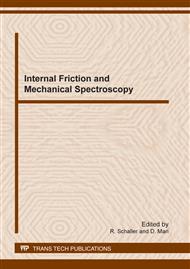p.422
p.428
p.434
p.443
p.449
p.455
p.461
p.467
p.473
Magnetic Field Dependent Damping of Magnetic Particle Filled Polypropylene
Abstract:
The behavior of internal friction Q-1 and dynamic shear modulus has been studied in polypropylene charged with either different volume fraction or size of magnetite (Fe3O4) particles, as a function of the applied magnetic field at 318 K. An increase of the alternating (AC) magnetic field oscillating with 50 Hz, leads to an increase of the internal friction. In addition, during the subsequently decreasing alternating magnetic field, the internal friction decreases, but a hysteretic behavior appeared. In fact, the internal friction of the decreasing part of magnetic field amplitude is found to be smaller than during the previously increasing amplitude part of the treatment with the alternating magnetic field. Subsequent magnetic treatment cycles, lead to successively decreasing internal friction. In contrast, during the increase of a direct (DC) magnetic field, the internal friction decreases and the elastic modulus increases. The behavior of the internal friction and the elastic modulus during the application of an oscillating magnetic field (AC) is discussed on the basis of the development of both, a new zone with different rheological characteristics than the matrix but of the same material (self-inclusion), and/or a deteriorated or damaged zone (chain’s cuts) of the polymer matrix in the neighborhood of the magnetite inclusion. These effects are promoted by the movement or small relative rotation of the magnetite particles related to the surrounding matrix controlled by the oscillating field. The behavior of the internal friction and elastic modulus during the application of a direct (DC) magnetic field is discussed on the basis of the increase of the internal stresses into the polymer matrix due to the promotion of the magnetomechanical stresses.
Info:
Periodical:
Pages:
449-454
Citation:
Online since:
January 2012
Price:
Сopyright:
© 2012 Trans Tech Publications Ltd. All Rights Reserved
Share:
Citation:


